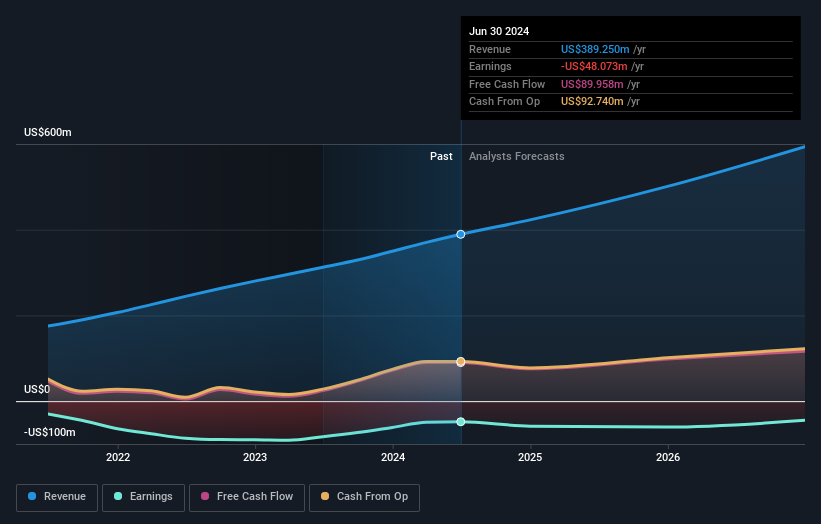- United States
- /
- Software
- /
- NasdaqGS:FROG
Positive week for JFrog Ltd. (NASDAQ:FROG) institutional investors who lost 6.6% over the past year

Key Insights
- Institutions' substantial holdings in JFrog implies that they have significant influence over the company's share price
- A total of 19 investors have a majority stake in the company with 51% ownership
- Insiders have been selling lately
If you want to know who really controls JFrog Ltd. (NASDAQ:FROG), then you'll have to look at the makeup of its share registry. And the group that holds the biggest piece of the pie are institutions with 72% ownership. Put another way, the group faces the maximum upside potential (or downside risk).
After a year of 6.6% losses, last week’s 4.7% gain would be welcomed by institutional investors as a possible sign that returns might start trending higher.
Let's take a closer look to see what the different types of shareholders can tell us about JFrog.
See our latest analysis for JFrog

What Does The Institutional Ownership Tell Us About JFrog?
Institutional investors commonly compare their own returns to the returns of a commonly followed index. So they generally do consider buying larger companies that are included in the relevant benchmark index.
We can see that JFrog does have institutional investors; and they hold a good portion of the company's stock. This implies the analysts working for those institutions have looked at the stock and they like it. But just like anyone else, they could be wrong. When multiple institutions own a stock, there's always a risk that they are in a 'crowded trade'. When such a trade goes wrong, multiple parties may compete to sell stock fast. This risk is higher in a company without a history of growth. You can see JFrog's historic earnings and revenue below, but keep in mind there's always more to the story.

Institutional investors own over 50% of the company, so together than can probably strongly influence board decisions. Hedge funds don't have many shares in JFrog. Our data shows that The Vanguard Group, Inc. is the largest shareholder with 7.2% of shares outstanding. With 5.9% and 4.1% of the shares outstanding respectively, Yoav Landman and Shlomi Haim are the second and third largest shareholders. Note that the second and third-largest shareholders are also Top Key Executive and Chairman of the Board, respectively, meaning that the company's top shareholders are insiders.
After doing some more digging, we found that the top 19 have the combined ownership of 51% in the company, suggesting that no single shareholder has significant control over the company.
While it makes sense to study institutional ownership data for a company, it also makes sense to study analyst sentiments to know which way the wind is blowing. There are a reasonable number of analysts covering the stock, so it might be useful to find out their aggregate view on the future.
Insider Ownership Of JFrog
The definition of an insider can differ slightly between different countries, but members of the board of directors always count. Company management run the business, but the CEO will answer to the board, even if he or she is a member of it.
Most consider insider ownership a positive because it can indicate the board is well aligned with other shareholders. However, on some occasions too much power is concentrated within this group.
Our most recent data indicates that insiders own a reasonable proportion of JFrog Ltd.. It is very interesting to see that insiders have a meaningful US$475m stake in this US$3.1b business. Most would be pleased to see the board is investing alongside them. You may wish to access this free chart showing recent trading by insiders.
General Public Ownership
With a 13% ownership, the general public, mostly comprising of individual investors, have some degree of sway over JFrog. This size of ownership, while considerable, may not be enough to change company policy if the decision is not in sync with other large shareholders.
Next Steps:
It's always worth thinking about the different groups who own shares in a company. But to understand JFrog better, we need to consider many other factors. Be aware that JFrog is showing 4 warning signs in our investment analysis , and 1 of those is a bit unpleasant...
But ultimately it is the future, not the past, that will determine how well the owners of this business will do. Therefore we think it advisable to take a look at this free report showing whether analysts are predicting a brighter future.
NB: Figures in this article are calculated using data from the last twelve months, which refer to the 12-month period ending on the last date of the month the financial statement is dated. This may not be consistent with full year annual report figures.
New: Manage All Your Stock Portfolios in One Place
We've created the ultimate portfolio companion for stock investors, and it's free.
• Connect an unlimited number of Portfolios and see your total in one currency
• Be alerted to new Warning Signs or Risks via email or mobile
• Track the Fair Value of your stocks
Have feedback on this article? Concerned about the content? Get in touch with us directly. Alternatively, email editorial-team (at) simplywallst.com.
This article by Simply Wall St is general in nature. We provide commentary based on historical data and analyst forecasts only using an unbiased methodology and our articles are not intended to be financial advice. It does not constitute a recommendation to buy or sell any stock, and does not take account of your objectives, or your financial situation. We aim to bring you long-term focused analysis driven by fundamental data. Note that our analysis may not factor in the latest price-sensitive company announcements or qualitative material. Simply Wall St has no position in any stocks mentioned.
About NasdaqGS:FROG
JFrog
Provides end-to-end hybrid software supply chain platform in the United States, Israel, India, and internationally.
Flawless balance sheet low.


